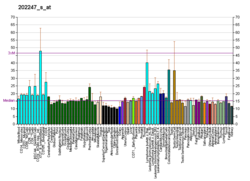Gene and spliced variants
The MTA1 is 715/703 amino acids long, coded by one of three genes of the MTA family and localized on chromosome 14q32 in human and on chromosome 12F in mouse. There are 21 exons spread over a region of about 51-kb in human MTA1. Alternative splicing from 21 exons generates 20 transcripts, ranging from 416-bp to 2.9-kb long. [16] However, open-reading frames are present only in eight spliced transcripts which code six proteins and two polypeptides and remaining transcripts are non-coding long RNAs some of which retain intron sequences. Murine Mta1 contains three protein coding transcripts and three non-coding RNA transcripts. [16] Among human MTA1 variants, only two spliced variants are characterized: ZG29p variant is derived from the c-terminal MTA1, with 251 amino acids and 29-kDa molecular weight; [17] and MTA1s variant generated from alternative splicing of a middle exon followed by a frame-shift, is 430 amino acids and 47-kDa molecular weight. [18]
Protein domains
The conserved domains of MTA1 include a BAH (Bromo-Adjacent Homology), an ELM2 (egl-27 and MTA1 homology), a SANT (SWI, ADA2, N-CoR, TFIIIB-B) and a GATA-like zinc finger. The C-terminal divergent region of MTA1 has an Src homology 3-binding domain, acidic regions, and nuclear localization signals. The presence of these domains revealed the role of MTA1 in interactions with modified or unmodified histone and non-histone proteins, chromatin remodeling, and modulation of gene transcription. [9] [19] [20] [21] MTA1 undergoes multiple post-translation modifications: acetylation on lysine 626, ubiquitination on lysine 182 and lysine 626, sumoylation on lysine 509, and methylation on lysine 532. [22] [23] [24] The structural insights of MTA1 domains are deduced from studies involving complexes with HDAC1 or RbAp48 subunits of the NuRD complexes. [19] [20] The MTA1s variant is an N-terminal portion of MTA1 without nuclear localization sequence but contains a novel sequence of 33 amino acids in its C-terminal region. The novel sequence harbors a nuclear receptor binding motif LXXLL which confers MTA1 with an ability to interact with estrogen receptor alpha or other type I nuclear receptors. [18] The ZG29p variant represents the c-terminal MTA1 with two proline-rich SH3 binding sites. [17] [25]
Regulation
Expression of MTA1 is influenced by transcription and non-transcriptional mechanisms. MTA1 expression is regulated by growth factors, growth factor receptors, oncogenes, environmental stress, ionizing radiation, inflammation, and hypoxia. [9] [12] The transcription of MTA1 is stimulated by transcriptional factors including, c-Myc, [26] SP1, [27] CUTL1 homeodomain, [28] NF-ḵB, [29] HSF1, [30] HIF-1a, [31] and Clock/BMAL1 complex, [32] and inhibited by p53. [33] Non-genomic mechanisms of MTA1 expression include post-transcriptional regulations such as ubiquitination by RING-finger ubiquitin-protein ligase COP1 [34] or interaction with tumor suppressor ARF [24] or micro-RNAs such as miR-30c, miR-661 and miR-125a-3p. [35] [36] [37] [38]
Targets
Functions of MTA1 are regulated by its post-translational modifications, modulating the roles of effector molecules, interacting with other regulatory proteins and chromatin remodeling machinery, and modulating the expression of target genes via interacting with the components of the NuRD complex including HDACs. [9] [19] [20]
MTA1 suppresses transcription of breast cancer type 1 susceptibility gene, [39] PTEN, [40] p21WAF, [41] guanine nucleotide-binding protein G(i) subunit alpha-2, [22] SMAD family member 7, [42] nuclear receptor subfamily 4 group A member 1, [43] and homeobox protein SIX3, [44] and represses BCL11B [45] as well as E-cadherin expression. [46] [47]
MTA1 is a dual coregulatory as it stimulates the transcription of Stat3, [48] breast cancer-amplified sequence 3, [49] FosB, [28] paired box gene 5, [50] transglutaminase 2, [51] myeloid differentiation primary response 88, [52] tumor suppressorp14/p19ARF, [27] [53] tyrosine hydroxylase, [54] clock gene CRY1, [32] SUMO2, [23] and Wnt1 and rhodopsin due to release of their transcriptional inhibition by homeodomain protein Six3, [44] [55]
MTA1 interacts with ERα and coregulatory factors such as MAT1, [56] MICoA, [57] [58] and LMO4, [59] which inhibits ER transactivation activity. [14] MTA1 also deacetylate its target proteins such as p53 and HIF and modulates their transactivation functions. [60] [61] Furthermore, MTA1 could potentially modulate the expression of target genes through the microRNA network as MTA1 knockdown results modulation of miR-210, miR-125b, miR-194, miR-103, and miR-500. [62] [63]
Cellular functions
MTA1 modulates the expression of target genes due to its ability to act as a corepressor or coactivator. MTA1 targets and/or effector pathways regulate pathways with cellular functions in both normal and cancer cells. [11] [12] Physiological functions of MTA1 include: its role in the brain due to MTA1 interactions with DJ1 [53] and endophilin-3; [64] regulation of rhodopsin expression in the mouse eye; modifier of circadian rhythm due to MTA1 interactions with the CLOCK-BMAL1 complex and stimulation of Cry-transcription; in heart development due to MTA1-FOG2 interaction; in mammary gland development as MTA1 depletion leads to ductal hypobranching, in spermatogenesis; in immunomodulation due to differential effects on the expression of cytokines in the resting and activated macrophage; in liver regeneration following hepatic injury; differentiation of mesenchymal stem cells into osteogenic axis; and a component of DNA-damage response. [11] In cancer cells, MTA1 and its downstream effectors regulate genes and/or pathways with roles in transformation, invasion, survival, angiogenesis, epithelial-to-mesenchymal transition, metastasis, DNA damage response, and hormone-independence of breast cancer. [9] [12]
This page is based on this
Wikipedia article Text is available under the
CC BY-SA 4.0 license; additional terms may apply.
Images, videos and audio are available under their respective licenses.







